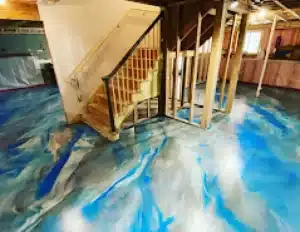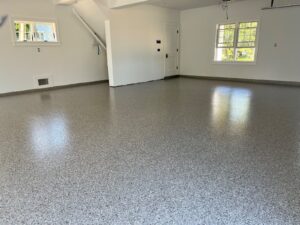Quick Answer to Your Search:
– Durability: Epoxy flooring outlasts many other types of floors. It’s tough.
– Customization: You can choose the look you want with many colors and finishes.
– Benefits: Easy to clean, resists chemicals, and good for the planet.
Epoxy flooring isn’t just a trend; it’s a smart choice for anyone wanting a durable, customizable, and eco-friendly option. Think of it as a superhero coat for your floors. This is particularly true for those of us keen on green building practices. You get a stylish look while also doing right by Mother Earth.
Epoxy is like a shield. It stands up to spills, heavy things, and even chemical attacks. For those busy areas in your home or workspace, epoxy keeps you worry-free. Plus, the cleaning is a breeze. A simple sweep or mop, and it’s as good as new, saving you time and reducing the need for harsh cleaning chemicals.
Customizing your space is the fun part. Whether you’re looking for a glossy showroom finish or a unique color that pops, epoxy flooring has got you covered. It’s like giving your floors a personal touch that also shouts, “I’m durable!”
And for those wearing the green builder hat, know this: Choosing epoxy is stepping towards sustainable design. It lasts longer, reducing the need for frequent replacements. Hello, lower carbon footprint!

Understanding Epoxy Flooring
When we dive into residential epoxy flooring, we’re looking at a game-changer in home aesthetics and functionality. Let’s break it down into simple pieces so it’s easy to grasp.
Resin and Hardener
At the heart of epoxy flooring, there are two main heroes: resin and hardener. Think of resin as the smooth, glossy finish you see, and hardener as the magic ingredient that makes the floor tough as nails. When these two are mixed, they start a chemical reaction, transforming from a liquid to a solid seamless surface. This process is not just about sticking things together; it’s about creating a bond that’s stronger and lasts longer than most friendships!
Seamless Finish
One of the coolest things about epoxy flooring is its seamless finish. Imagine a floor without cracks or crevices where dirt can hide. That’s what epoxy delivers. This seamless nature makes it a breeze to clean, giving you more time to do things you love, instead of scrubbing floors. Plus, it looks incredibly sleek and modern, elevating the look of any room.
UV Inhibitors
Now, let’s talk about sunlight. Just like sunscreen protects your skin, UV inhibitors in some epoxy floorings protect your floor from the harsh effects of the sun. These special additives prevent the color of your floor from fading over time, ensuring your floor stays looking as vibrant and shiny as the day it was installed. It’s like having a permanent filter that keeps your floor in its best light.
In a nutshell, residential epoxy flooring is more than just a pretty surface. It’s a durable, low-maintenance, and stylish choice that can withstand the test of time and sunlight. Whether you’re renovating or building new, understanding these key components—resin and hardener, seamless finish, and UV inhibitors—can help you make an informed decision that you’ll be happy with for years to come.
Keep in mind that the beauty and durability of epoxy flooring offer an unmatched appeal, making it a smart investment for any homeowner. Next, we’ll explore the advantages and considerations to keep in mind, ensuring your flooring not only looks fantastic but also meets your home’s unique needs.
Advantages of Epoxy Flooring
When it comes to choosing the right flooring for your home, weigh the benefits. Residential epoxy flooring stands out for several reasons, each contributing to its growing popularity among homeowners. Let’s break down these advantages:
Durability
Epoxy floors are incredibly tough. They’re designed to withstand a lot of wear and tear, making them perfect for high-traffic areas in your home. From the weight of heavy furniture to the constant foot traffic of a busy family, epoxy flooring holds up impressively. As one testimonial mentioned, a customer was thrilled with how their epoxy garage floor turned out, highlighting the material’s resilience and the professional finish that resisted daily demands.
Easy Maintenance
Keeping an epoxy floor clean is a breeze. You don’t need any special cleaners—just a simple sweep and a mop with warm water will do the trick. This ease of maintenance is a huge plus for anyone looking to save time and effort. Spills and stains? No problem. They wipe right off thanks to the non-porous surface of epoxy flooring.
Aesthetic Appeal
Epoxy flooring is not just about function; it’s also about form. The customization options are nearly endless, with a vast array of colors, patterns, and finishes available. Whether you’re going for a sleek, modern look or something more traditional, epoxy can be tailored to fit your style. It can transform any space, adding brightness and character.
Water-Resistant
One of the functional beauties of epoxy flooring is its resistance to water. This makes it an ideal choice for areas prone to spills or moisture, like kitchens, bathrooms, and basements. Unlike some other flooring options, you won’t have to worry about water damage or mold growth with an epoxy floor.
Slip-Resistant
Safety is a top concern in any home, and epoxy flooring addresses this by offering slip-resistant options. With the addition of a grit additive, the floor’s surface can provide more traction, reducing the risk of slips and falls. This feature is particularly beneficial in wet areas or for families with young children or elderly members.
In conclusion, residential epoxy flooring offers a compelling combination of durability, easy maintenance, aesthetic flexibility, water resistance, and safety. These benefits make it a strong contender for anyone looking to upgrade their home flooring. We’ll delve into the installation process, providing insights into how you can achieve these fantastic results in your own home.
Disadvantages of Epoxy Flooring
While residential epoxy flooring offers a multitude of benefits, it’s crucial to consider the potential downsides before making a decision. Understanding these aspects will ensure you’re fully informed about what to expect.
Sensitivity to UV Light
One notable downside is its sensitivity to UV light. Over time, exposure to sunlight can cause epoxy floors to yellow or fade, affecting their aesthetic appeal. This is particularly important for areas in your home that receive ample natural light.
Installation Time and Fumes
The installation process can be lengthy, often taking several days to complete. During this time, the area must be well-ventilated to avoid the buildup of fumes from the epoxy resin, which can be unpleasant and potentially harmful without proper ventilation.
Slipperiness When Wet
Although epoxy flooring is generally slip-resistant, it can become slippery when wet. This can pose a risk in areas prone to moisture, such as bathrooms or kitchens. However, this issue can be mitigated with the use of non-slip additives in the epoxy mixture.
Potential for Cracks and Peeling
If not properly installed, epoxy flooring can peel or crack over time, leading to an unsightly appearance and the need for repairs. This is often due to inadequate surface preparation or the concrete beneath shifting or settling after the epoxy has been applied.
Cost Considerations
While epoxy flooring can be a long-term investment due to its durability, the initial cost can be higher than some other flooring options. This includes both the materials and the labor for professional installation, which is highly recommended to avoid the aforementioned issues with cracks and peeling.
Temperature Sensitivity
Epoxy flooring is also sensitive to temperature during the application process. Extreme temperatures can affect the curing process, potentially compromising the durability and appearance of the floor. This requires careful planning to ensure the temperature conditions are just right.
Sound and Comfort
Epoxy floors can produce a hollow sound when walked upon, which might be a concern in living spaces where noise reduction is desired. Additionally, they can feel hard underfoot, lacking the warmth and comfort provided by softer flooring options like carpet or vinyl.
Understanding these disadvantages is essential in making an informed decision about whether residential epoxy flooring is the right choice for your home. While the benefits are significant, weighing them against the potential drawbacks will help ensure your satisfaction with the end result. In the next section, we’ll explore the installation process, giving you a clearer picture of what to expect when opting for an epoxy flooring solution.

Installation Process
Installing residential epoxy flooring is not just about pouring and spreading a mixture over your floor. It’s a detailed process that ensures durability, beauty, and satisfaction for years to come. Let’s dive into the steps involved.
Surface Preparation
The first and most crucial step is preparing the surface. This isn’t just about sweeping away the dust. The concrete floor must be clean, dry, and free from any oil, grease, or previous coatings. Professional teams like Topcoat Services use industrial-grade equipment to thoroughly clean and sometimes grind the concrete to create a rough texture. This texture is key because it helps the epoxy coating adhere better, ensuring longevity and preventing peeling or bubbling.
Mixing Epoxy
Once the floor is prepped, it’s time to mix the epoxy resin with a hardener. This step is more science than art. The two components must be mixed in the precise ratio recommended by the manufacturer. This ratio triggers the chemical reaction necessary for the epoxy to cure and harden properly. It’s a delicate balance — too much or too little of one component can affect the durability and finish of the flooring.
Applying Coatings
After mixing, the epoxy is applied to the floor. This step requires skill and attention to detail. Specialists use tools designed for epoxy application to spread the mixture evenly across the surface, paying extra care to edges and hard-to-reach areas. The goal is a smooth, flawless finish without any bubbles or uneven spots.
Curing Time
The final step in the installation process is the curing time. Epoxy needs time to harden and reach its full strength. This can take anywhere from 24 hours to several days, depending on the epoxy formula and the conditions in your home, like humidity and temperature. During this time, it’s crucial to keep the area free from traffic and disturbances.
Curing is not just about waiting; it’s about transforming. As the epoxy cures, it undergoes a chemical process that turns it into a durable, resilient surface capable of withstanding heavy use and spills.
Remember: The installation of residential epoxy flooring is a process that requires precision, patience, and expertise. While it might be tempting to consider it as a DIY project, professional installation by teams like Topcoat Services ensures that each step is performed correctly, resulting in a floor that is not only beautiful but also long-lasting and durable.
As we move into the customization options available for your home, keep in mind the importance of the installation process. It’s the foundation that allows for the creativity and personalization that makes epoxy flooring so appealing.
Customization Options for Your Home
When it comes to making your home truly yours, the details matter. That’s why residential epoxy flooring offers a wide range of customization options. Let’s dive into how you can tailor your floors to fit your unique style.
Color Choices
Imagine any color, and chances are, you can have it with epoxy flooring. From soothing pastels to vibrant primaries, the spectrum is yours to command. This flexibility allows you to match your floors with the rest of your home’s decor seamlessly. Whether you want a single, bold color or a combination that creates a specific mood, the choice is yours.
Metallic Finishes
For those looking to add a touch of luxury and depth to their floors, metallic finishes are a game-changer. These finishes use metallic pigments to create a floor that’s not just a color but a dynamic surface that shifts and shimmers as you move around it. Each metallic floor is unique, offering a one-of-a-kind look that can’t be replicated. It’s like having a custom piece of art under your feet.
Flake or Gravel Coatings
If you’re after texture and complexity, consider adding flakes or gravel to your epoxy coating. These additions can mimic the look of granite or quartz, providing a speckled effect that adds depth and interest to your floors. You can choose the size and color of these flakes or gravel, allowing for further personalization. This option is perfect for adding character to utility spaces or creating a focal point in living areas.
Personalized Designs
The ultimate in customization comes from creating personalized designs with your epoxy flooring. Whether it’s a family crest, a geometric pattern, or an abstract design that speaks to you, it can be incorporated into your floor. This level of customization ensures that your floor is like no other, truly reflecting your personal style and story.
The beauty of epoxy flooring doesn’t just lie in its appearance. Its durability means that your custom designs will stand the test of time, resisting wear and tear while maintaining their stunning looks.
As we consider the maintenance and care of these beautiful floors, the ease of upkeep is another reason why epoxy flooring is such a popular choice for homes.
Maintenance and Care
Maintaining your residential epoxy flooring is straightforward and doesn’t require complex procedures. Let’s dive into how you can keep your floors shining, avoid damage, and ensure they last for years.
Cleaning Techniques
Sweep Regularly: Dirt and grit can act like sandpaper, wearing down the surface of your floor. A simple daily sweep can prevent this.
Mop with Mild Cleaners: Use a mop and warm water mixed with a pH-neutral cleaner. Harsh chemicals can damage the epoxy’s glossy finish, so stick to gentle solutions.
Spills: Wipe up spills as soon as they happen. Epoxy is resistant to stains, but prompt cleaning helps maintain its pristine look.
Avoiding Damage
Furniture Pads: Place protective pads under furniture legs to prevent scratches when moving items around.
Rugs at Entrances: Rugs can catch dirt and grit from shoes, reducing what gets tracked onto your floors.
Avoid Sharp Objects: Sharp tools or dropped knives can gouge the floor. Use caution and protective coverings during activities that might risk damage.
Hot Tire Pickup: This is a specific concern for garages. Choose an epoxy with a top coat resistant to marks left by hot tires to avoid this issue.
Longevity Tips
Reapplication: Depending on the level of traffic, your floor might need a new top coat every few years. This refreshes its appearance and maintains its protective qualities.
UV Protection: If your epoxy floor is exposed to sunlight, ensure it has UV inhibitors to prevent fading and discoloration over time.
Professional Inspection: Having a professional check your floor periodically can identify any potential issues before they become major problems.
Follow Manufacturer’s Guidelines: Always adhere to the care instructions provided by your installer or the product manufacturer for the best results.
By following these simple maintenance and care steps, your residential epoxy flooring will continue to look stunning and perform excellently for many years. The key to longevity is regular care and prompt attention to any spills or damage. With a little effort, your epoxy floors will remain a beautiful and durable part of your home.
Moving on, let’s explore the cost considerations of epoxy flooring to help you understand the initial investment and long-term savings compared to other flooring options like vinyl.
Cost Considerations
When considering residential epoxy flooring, look at both the short-term and long-term financial implications. This includes the initial investment, potential savings over time, and how epoxy compares to other popular flooring options, such as vinyl.
Initial Investment
The upfront cost of residential epoxy flooring can vary widely based on several factors, including the size of the area to be covered, the condition of the existing floor, and the level of customization desired. Generally, professional installation of epoxy flooring can be more costly upfront than traditional flooring options like carpet or basic vinyl due to the specialized materials and labor involved. However, it’s crucial to consider this initial investment in the context of the long-term benefits and savings epoxy flooring offers.
Long-Term Savings
Epoxy flooring is renowned for its durability and longevity. Unlike carpet or hardwood, which may need to be replaced every decade or so, a well-installed epoxy floor can last for many years with minimal maintenance. This durability translates to significant long-term savings, as the need for repairs, replacements, and deep cleanings is greatly reduced. Additionally, the ease of maintenance means lower ongoing costs for cleaning supplies and professional cleaning services.
Comparison with Vinyl Flooring
Vinyl flooring is another popular choice for residential spaces, often chosen for its affordability and variety of designs. While vinyl can initially be less expensive than epoxy, it typically doesn’t offer the same level of durability or longevity. Vinyl floors can be prone to tearing, staining, and wear over time, especially in high-traffic areas, leading to potential replacement or repair costs down the line.
Moreover, while both epoxy and vinyl flooring offer a range of design options, epoxy’s ability to be customized with colors, patterns, and textures can create a unique and high-end look that’s hard to achieve with vinyl. This aesthetic appeal, combined with its superior durability, makes epoxy a worthwhile investment for many homeowners looking for both style and substance in their flooring.
In conclusion, while the initial investment in residential epoxy flooring may be higher than some alternatives, the long-term savings and durability it offers often make it a more cost-effective choice in the long run. Compared to vinyl flooring, epoxy provides a stronger, longer-lasting surface that can handle the demands of daily life while maintaining its appearance and functionality.
We’ll dive into some of the most frequently asked questions about residential epoxy flooring to help further clarify any uncertainties you might have.

Frequently Asked Questions about Residential Epoxy Flooring
Is Epoxy Flooring Good for All Areas of the House?
Epoxy flooring is incredibly versatile and can be a great choice for many areas of your home. It’s particularly popular for garages, kitchens, basements, and bathrooms due to its durability and resistance to moisture. However, its application isn’t limited to these areas alone. With the right preparation and care, epoxy can also be a stunning addition to living rooms and bedrooms, especially when customized options like metallic finishes or personalized designs are used.
One thing to keep in mind is that epoxy can be slippery when wet, although this can be mitigated with texturizing additives. So, for areas like the bathroom or kitchen where spills are more likely, consider these anti-slip measures to ensure safety.
How Long Does Residential Epoxy Flooring Last?
The lifespan of epoxy flooring can vary based on several factors, including the quality of the installation, the level of foot traffic, and how well it’s maintained. On average, residential epoxy flooring can last anywhere from 10 to 20 years, or even longer if it’s properly cared for. It’s worth noting that areas with less foot traffic, like basements, may see their epoxy flooring last on the higher end of that range, while high-traffic areas might be on the lower end.
The key to longevity is proper installation and regular maintenance. Epoxy floors that are well-installed and regularly cleaned can look stunning and perform well for many years.
Can I Install Epoxy Flooring Myself?
While DIY epoxy kits are available, the installation of epoxy flooring can be quite complex and demanding. Proper surface preparation is crucial to avoid peeling and cracking, and achieving a smooth, bubble-free finish requires precision. Professional installation by experienced technicians, like those from Topcoat Services, ensures that the flooring is applied correctly, with attention to detail that DIY efforts might miss.
Professionals also have access to high-quality materials and the expertise to handle any unexpected issues that may arise during the application process. If you’re looking for a flawless finish and a durable floor, it’s highly recommended to opt for professional installation. The beauty and longevity of your floor depend significantly on the quality of the installation.
In conclusion, residential epoxy flooring offers a durable, customizable, and visually appealing option for various areas of your home. With proper installation and care, it can be a long-lasting investment that adds value and beauty to your space. If you’re considering epoxy for your home, consulting with a professional service like Topcoat Services can provide you with the insight and expertise to make the best decision for your specific needs and preferences.
Conclusion
Choosing the right flooring for your home is more than just about aesthetics; it’s about making a sustainable choice that benefits both you and the environment. Residential epoxy flooring stands out not just for its durability and versatility, but also for its eco-friendly nature. At Topcoat Services, we’re committed to providing solutions that align with the principles of sustainable design, ensuring that your flooring choice contributes positively to the environment and your well-being.
Sustainable Design is at the forefront of our approach. Epoxy flooring is a testament to this ethos, offering a low-maintenance, high-performance surface that’s built to last. Its durability means less frequent replacements, reducing waste. Additionally, the materials used in our epoxy flooring solutions are chosen with the environment in mind, minimizing the impact on our planet.
At Topcoat Services, our commitment goes beyond just installing a floor. We aim to educate and guide our clients through the myriad of design and application possibilities that epoxy offers. Whether you’re seeking a sleek, modern look with metallic finishes or a classic style with solid colors, our team is equipped to bring your vision to life. We leverage the latest techniques and eco-friendly practices to ensure that your flooring is not just visually appealing but also beneficial to the planet.
Embarking on a new flooring project can be daunting, but we’re here to assist you every step of the way. From the initial design consultation to the final application, our team ensures a seamless process, delivering a floor that exceeds your expectations in both performance and sustainability.
Choosing residential epoxy flooring is not just about selecting a flooring option; it’s about making a long-term investment in the beauty and health of your space. With Topcoat Services, you’re choosing a partner dedicated to excellence, sustainability, and innovation. Let us help you transform your space with flooring that stands the test of time, both in style and function.
For those considering a new flooring project, the choice you make today will affect your home and the environment tomorrow. Make a choice that you’ll be proud of for years to come. Discover how we can assist with your residential epoxy flooring needs and start your journey towards a sustainable, aesthetically pleasing space.









